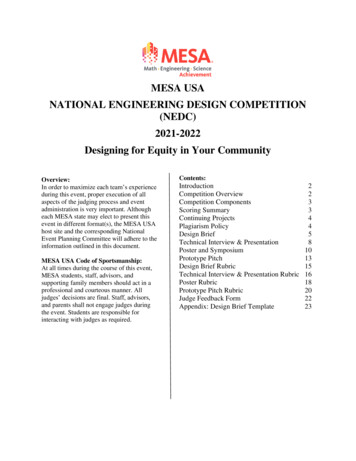
Transcription
RESEARCH BRIEF October 2019It’s About TimeHow Work Schedule Instability Matters forWorkers, Families, and Racial InequalityMany Americans are working, but poor. Along with low wages and few benefits, the working poorfrequently find themselves up against erratic work schedules, with hours and shifts that change day-today and week-to-week with little advance notice. Particularly in the food-service and retail sectors, whichemploy 17% of American workers, such unstable and unpredictable work schedules are widespread.1 Now,newly available data from The Shift Project offers unprecedented insight into the prevalence of unstablework scheduling conditions and the consequences of this instability for workers and their children.Among 30,000 employees at 120 of the largest retail andfood-service firms in the United States, the large majority of workers have little advance notice of their schedules: two-thirds have less than two weeks’ notice, andhalf of those get less than a week’s notice (Figure 1, nextpage). Workers’ schedules are also often changed at thelast minute, with 14% reporting at least one cancelledshift in the last month and 70% reporting at least onechange to the timing of one of their shifts in the pastmonth. Many workers are expected to work on-callshifts (25%) and back-to-back closing-then-opening shiftsseparated by less than 11 hours (“clopenings”) (50%).From the perspective of workers, this is not desirable schedule flexibility, but rather unpredictabilityand instability imposed by employers, often with theaid of workforce management technology and algorithms. We find that 80% of workers have little to noinput into their schedules and that 69% are requiredby their employer to keep their schedules “openand available” to work whenever needed. Askedif they would like a more stable and predictableschedule, 75% of workers say that they would (Figure 2). This precarious scheduling occurs against abackdrop of insufficient work hours. We find that athird of workers are involuntarily working part-time:They usually work fewer than 35 hours and wouldlike to be scheduled for more hours at their job.Unpredictable and unstable work schedules in retail and food service are common, but they are notuniversal. Within these sectors, there is variation inthe degree to which employees are exposed to precarious scheduling. We take advantage of this variation, comparing workers exposed to unstable andunpredictable schedules at work to otherwise similarworkers in similar jobs who have a greater degree ofstability. These comparisons reveal the widespreadnegative consequences of unstable and unpredictable schedules for workers and their families.We show that while exposure to just-in-time scheduling is high for all groups of workers, it is also fundamentally unequal, as workers of color, and particularly women of color, are exposed to the most unstableand unpredictable work scheduling practices.We show how exposure to unstable and unpredictable scheduling practices gives rise to householdeconomic insecurity and dramatic increases inhunger and other hardships.We show how parental exposure to unstable workschedules has intergenerational consequences, bycreating instability in children’s routines and carearrangements and also manifesting in children’sheightened anxiety and acting out.Daniel Schneider, UC Berkeleydjschneider@berkeley.eduKristen Harknett, UCSFkristen.harknett@ucsf.edushift.berkeley.edu
Low-wage workers have high rates of low-quality schedulesPercentage of U.S. food and retail workers that experience each type of scheduling problem100%806040200At least oneAt least onecancelled shift on-call shift inin the past the past monthmonthWorks avariablescheduleAt least oneLess than 2At least oneclopening in weeks' noticelast-minutethe past monthshift change inthe past monthNote: Clopening shifts are back-to-back opening and closing shifts.Source: Authors’ tabulations from The Shift Project survey.Figure 1We show that theschedules within jobsjob instability, leadingthat imposes costs onday-to-day instability ofis inextricably linked toto turnover for workersindividuals and on firms.These findings are reported in a set of five workingpapers, released as part of the Washington Centerfor Equitable Growth working paper series. Thisreport shares highlights from these five papers.Racial/Ethnic Inequality in WorkSchedulingPervasive and persistent racial and ethnic inequalities in the American labor market in hiring, wages, andfringe benefits packages are well-documented in research.2 But, far less is known about racial inequalityin work schedules.3 Yet, whereas wage and benefit levels are often regularized by tenure or job grade withinorganizations, front-line managers have a great dealof discretion in work scheduling, raising the risk thatmanagers’ conscious or unconscious racial biases couldproduce racial and ethnic inequality in scheduling.4IT’S ABOUT TIMEBlack and Latinx workers are over-represented inthe retail and food-service sectors, where workschedule instability is prevalent.5 We also findevidence of substantial racial and ethnic inequalityin work scheduling among workers in retail andfood service. For instance, while 13% of whiteworkers report at least one cancelled shift in thelast month, the share is 30% higher, at 17%, for nonwhite workers. We see this same pattern acrossa range of indicators of unstable work schedules:non-white workers are 10% to 20% more likely toexperience on-call shifts, clopenings (back-toback closing-then-opening shifts separated by lessthan 11 hours), and involuntary part-time work.Overall, when we consider all measures of schedule instability together, we see large racial inequalities in work schedules, represented by theblue bars in Figure 3. Exposure to schedule instability is 16% higher among non-white workerscompared with white workers. This gap is largest, though, for women of color, at 18% (vs. 12%among men), and the gap between white andLatinx workers, at 17%, is somewhat larger than2
Low-wage workers have little control over their low-quality schedulesPercentage of U.S. food and retail workers that experience each indicator of limited worker control100%80A third of workerswork part time,but want to workmore hoursUnfortunately, they have little control over their schedules6040200Involuntarilyworkingpart timeRequired tokeep schedules"open & available"Would like morestable andpredictableschedulesHave little inputinto schedulesSource: Authors’ tabulations from The Shift Project survey.Figure 2the gap between white and Black workers (14%).In fact, even when we compare among workerswith the same demographics and the same educational attainment who work at the exact samecompanies, we find that workers of color still havemore unstable and unpredictable work schedules(Figure 3, orange bars). Even when comparingwhite and non-white workers with similar characteristics within the exact same firms, a 5% to 10%gap in exposure to precarious scheduling remains.The remaining race gap could come about if managerial discretion in assigning schedules gives rise todiscriminatory treatment. If managers’ conscious orunconscious racial bias affects work schedule allocations, then non-white workers could be at a severedisadvantage. While 80% of white hourly workersreport that their direct supervisor is also white, only38% of non-white hourly workers report that theirdirect supervisor is of their same race. It turns outthat having a manager of a different race accountsfor 25% of the remaining scheduling gap betweenwhite workers and workers of color and 63% of theremaining gap between Black and white workers.IT’S ABOUT TIMEEconomic Consequences ofPrecarious SchedulesOver the past thirty years, prominent politiciansand policy makers have argued that the surestroute out of poverty is employment. Yet, recentanalyses show that millions of workers in America are impoverished and at least a third of households with a working adult experience materialhardship—such as not being able to afford enoughto eat, stable housing, or needed medical care.6While a job with a living wage, good benefits, and astable schedule might indeed provide economic security, jobs in the United States have become moreand more precarious in terms of wages and benefits, but also very much in terms of unstable andunpredictable work scheduling practices.7 Suchscheduling practices could lead to material hardship by causing income volatility, interfering withpublic benefits eligibility, over-burdening informalsupport networks, and even making it difficult toplan for the future.83
Workers of color have worse schedules than their white co-workersDiscrepancy in levels of exposure to unstable and unpredictable scheduling practices betweenworkers of color and white workers at U.S. food and retail companiesOverall discrepancy betweenworkers of color & white workers20%Discrepancy between similarworkers at the same employer151050All workers ofcolorWomen of colorMen of colorBlack workersLatinx workersNote: In this context, unstable and unpredictable scheduling practices include cancelled, on-call, and clopening shifts, involuntary part-timework, and difficulty getting time off. The level of exposure is measured by counting the number of these practices workers are exposed to.Analyses of gender subgroups compare women of color to white women, and men of color to white men.Source: Adam Storer, Daniel Schneider, and Kristen Harknett, "What Explains Race/Ethnic Inequality in Job Quality in the Service Sector?"(Washington, D.C.: Washington Center for Equitable Growth, 2019).Figure 3We find that material hardship is common amonghourly workers at the nation’s largest retail andfood-service firms. Overall, six in ten hourly workersexperienced at least one material hardship overthe prior year. A third of workers reported hungerhardship—that is, a third reported at least one timeover the past year when they went hungry and/orrelied on free food (such as from a soup kitchen orfood pantry) because they couldn’t afford to buyenough food. One in six workers experienced ahousing hardship—staying with other people becauseof housing problems and/or staying in a shelter,abandoned building, or other non-regular housing.But, comparing among workers with the same wages,workers who had more unstable and unpredictable workschedules were at even higher risk of material hardship.For example, 42% of workers who had shifts cancelledreported hunger hardship as compared with 29% ofworkers who did not have cancelled shifts (Figure 4).Short notice of work schedules was also associated withhunger: 36% of workers with less than three days of advance notice experienced hunger hardship, comparedwith 28% of those with at least two weeks’ advance notice. On-call shifts and last-minute changes to schedule timing similarly raised the risk of hunger hardship,of residential hardship, and of any hardship (Figure 5).Measures of Material HardshipYou received free food or mealsbecause you did not have enoughmoney.You went hungry because youcouldn’t afford to eat.You borrowed money from friendsor family to help pay the bills.IT’S ABOUT TIMEYou did not pay the full balanceof your gas, oil, or electricity billbecause you did not have enoughmoney.You stayed in a shelter, abandonedbuilding, automobile, or any otherplace not meant for regular housing,even for one night.You moved in with other people(even for a little while) because offinancial problems.Someone in your household neededmedical care, but did not visit a doctor or go to the hospital because ofthe cost.4
Shorter notice and cancelled shifts are associated with hunger hardshipProbability of experiencing hunger hardship by type of schedule among U.S. food and retail workers.Hardship includes relying on free food and meals or going without eating due to financial need.40%40%30302020101002 weeks’ notice 0-2 days’ noticeof scheduleof schedule0No cancelledshiftCancelled shiftSource: Daniel Schneider and Kristen Harknett, "Hard Times: Routine Schedule Unpredictability and Material Hardship among Service Sector Workers"(Washington, D.C.: Washington Center for Equitable Growth, 2019).Figure 4Shorter notice and cancelled shifts are linked to increased housing hardshipProbability of experiencing housing hardship by type of schedule among U.S. food and retail workers. Hardshipincludes moving in with others due to financial need or staying in a place not meant for regular housing.25%25%2020151510105502 weeks’ notice 0-2 days’ noticeof scheduleof schedule0No cancelledshiftCancelled shiftSource: Daniel Schneider and Kristen Harknett, "Hard Times: Routine Schedule Unpredictability and Material Hardship among Service Sector Workers"(Washington, D.C.: Washington Center for Equitable Growth, 2019).Figure 5IT’S ABOUT TIME5
Consequences of PrecariousSchedules for ChildrenInsufficient and volatile work hours also matter.Workers who don’t get enough work hours experience more hunger hardship and more hardshipoverall. But, it is not just insufficiency, but alsovolatility, that matters. We calculate the degree towhich work hours are volatile—that is, vary fromweek-to-week—by comparing the number of workhours in the week in the last month when a workerhad the most hours against the week when they hadthe fewest. A worker whose lowest week was 20hours and highest week was 30 hours would have33% variation in hours—the average for our sample.Compared to workers with steady hours, workersat the 75th percentile for instability (a 50% swingin hours), had a 13% higher risk of hunger hardship and an 11% higher risk of residential hardship.If one vision of the retail and food-service workforceis of teenagers starting out and working their firstjob on their way up the career ladder, the reality isstarkly different. Over 70% of retail and food-service workers are over the age of 25, and one in tenAmerican children has a parent working in the sector.9 That matters because the costs of precariouswork may not simply be fleeting in the life courseor even confined to a single generation. Instead,when parents work unstable and unpredictablework schedules, their children may also be affected.The foundations for how we fare later in life—inschool, in work, in upward mobility—are laid early inchildhood.10 Schools and neighborhoods have important effects on child development, but for young children, the family is a formative setting and one thatis significantly affected by parents’ job quality.11 Theinstability and unpredictability that parents experi-Employment is no guarantee of economic security, as many American workers are employed yet still experience serious materialhardships. Notably, material hardship variedin proportion to the amount of temporal precarity workers experienced from their jobs.Parents with just-in-time schedules struggle to find childcareNumber of days per year in which young children of U.S. food and retail workers receive childcarefrom a sibling younger than 10 years of age or lack childcare (for any period of time)Parents without oncall or last-minuteschedule changes*Parents who workon-call and experiencelast-minute schedulechangesAprilerNovemb3 126 21 2218 7 1430yJanuar MarchMAYMAYJulyerNovembrOCtobe9 days annuallyJune17211 18 424 1 13 8 15 4 7 23 288 1yJanuar trOCTobererDEcemberOCTobeNovemb15 days annuallyNumber of days* These parents may experience other scheduling practices that impact childcare, such as receiving their schedule less than a week in advance.Source: Daniel Schneider, Kristen Harknett, and Sigrid Luhr, “Who Cares if Parents have Unpredictable Work Schedules?: The Association betweenJust-in-Time Work Schedules and Child Care Arrangements”(Washington, D.C.: Washington Center for Equitable Growth, 2019).Figure 6IT’S ABOUT TIME6
As parents' schedule instability increases, child behavioral problems increaseIncreased level of U.S. children's sad and mad behaviors associated with exposure to parents'level of schedule instability relative to children whose parents have stable schedulesOne form ofschedule instabilityTwo forms ofschedule instabilityThree forms ofschedule instabilityAll forms ofschedule instability75%Sad behaviorsMad behaviorsWorrying, feeling guilty,depressed, insecure50Arguing, disobedience,tantrums, aggression250SadMadSadMadSadMadSadMadSource: Daniel Schneider and Kristen Harknett, "Parental Exposure to Routine Work Schedule Uncertainty and Child Behavior" (Washington, D.C.:Washington Center for Equitable Growth, 2019).Note: Forms of parental schedule instability include on-call, cancelled, and clopening shifts, and last-minute schedule changes. Sad and madchild behaviors were measured using scales for internalizing and externalizing behaviors constructed from the Child Behavior Check-List BriefProblem Monitor.Figure 7ence in their work schedules may spill over at homeand negatively affect children by undermining household economic security, upsetting family routines anddevelopmental child care time, and introducing strainand stress into everyday interactions that would ideally be warm and supportive.12 Ultimately, unstableand unpredictable work schedules may reduce intergenerational mobility by constraining children’sopportunities from the start. We trace how parentalexposure to unstable and unpredictable work schedules may spill over to affect children in two domains.Consistent and quality childcare is essential for healthychild development. But, unstable and unpredictableschedules impose a degree of chaos on parents’ livesthat inevitably spill over to their children’s care arrangements. We find that parents’ exposure to on-callwork and last-minute shift changes are associated witha reliance on informal care arrangements. In particular,we find that when parents work on-call shifts or havelast-minute changes to their schedules, they are morelikely to ask siblings to provide care for their youngerbrothers and sisters (Figure 6). Many of these siblingsare children themselves, with parents having even toIT’S ABOUT TIMErely on children younger than age ten for childcarewhen the alternative is missing the chance for needed income or even risking their job by missing work.Kids thrive in environments of security, consistency,and support. These environments are difficult to maintain in the face of on-call shifts, last minute cancellations, changes to schedule timing, and clopening shifts.We find that there is significantly more household economic insecurity in families with young children whenparents work more unstable and unpredictable workschedules. We also find that parents have much lesstime for developmental activities with children, suchas reading a book together or having a family meal,when their schedules are unstable and unpredictable.Parents’ wellbeing also suffers: they sleep less well,are more psychologically distressed, and are less happy when working unstable and unpredictable workschedules—a relationship that we’ve documented forall workers, not just parents.13 The weight of householdeconomic insecurity, parental stress, and disruptedfamily routines imposed by unstable and unpredictablework schedules ultimately depresses child wellbeing.Children whose parents work more unstable and7
unpredictable schedules suffer (Figure 7, previouspage). One yardstick for the costs of a parent working an unstable and unpredictable schedule is thattheir children show more “internalizing” or sad behaviors—feeling worthless, anxious, guilty, self-conscious, unhappy, or worried. We find that childrenwhose parents work on-call, have cancelled shifts,timing changes, or work clopenings score significantly higher on this measure. Another yardstick is thatchildren show more “externalizing” or mad behaviors—arguing, destroying things, being disobedient,stubborn, having temper tantrums, or making threats.Here, the impact of on-call shifts, cancellations, timing changes, and clopenings is smaller, but still significant, elevating these externalizing behaviors as well.Consequences of PrecariousSchedules for Job TurnoverUnstable and unpredictable work schedules don’tjust shape life for workers and their families in themoment. These precarious scheduling practices alsoset workers’ career trajectories. We find that precarious scheduling, including short advance notice andon-call shifts, significantly increases job turnover.Retail and food service are known to be short-tenure and high-turnover industries. Our data confirmthis. We find a six-month turnover rate of 28%. Wealso find that workers who had unstable and unpredictable work schedules have significantly higher turnover rates (Figure 8). For example, 35% ofthose who had at least one on-call shift and 42%of those who had at least one cancelled shift in themonth prior to first being surveyed were no longer at their job six months later. While the turnover rate was 24% for workers with at least twoweeks’ advance notice of their schedules, it was 39%for those with less than 72 hours advance notice.Having an unstable and unpredictable work schedule leads to turnover because precarious schedules make it untenable for workers to meet theirpersonal needs and care for their families. Workers with precarious schedules also leave theirjobs because they feel unfairly treated by theirTurnover rates are higher when notice is short and schedule quality is lowProbability of job turnover by type of work schedule among U.S. food and retail workers40%30201002 weeks 0–3 daysAmount of schedule noticeNoYesWorks clopening shiftsNoYesWorks on-call shiftsNoYesHas had cancelled shiftsNote: Clopening shifts are back-to-back opening and closing shifts.Source: Joshua Choper, Daniel Schneider, and Kristen Harknett, "Uncertain Time: Precarious Schedules and Job Turnover in the U.S. ServiceSector" (Washington, D.C.: Washington Center for Equitable Growth, 2019).Figure 8IT’S ABOUT TIME8
managers and dissatisfied with their jobs. Inturn, job loss has well-documented negative effects on future earnings and employment, aswell as on psychological wellbeing and health.14ConclusionThe Shift Project provides a valuable new resourcefor understanding how the time dimension ofjob quality—predictability and stability in workschedules—affects the livelihoods and lives of lowwage workers in America. The Shift Project detailsthe routine instability that workers in retail andfood service face, and the host of consequencesthat follow from this instability. The retail andfood service sectors now employ 17% of workersin the United States, nearly twice as many as workin the manufacturing sector.15 Work scheduleinstability and its consequences, therefore, deeplyaffect a large swath of American families. Unstablework schedules assigned with little advancednotice exact a toll on workers and their children.With new data from The Shift Project, we can nowdocument a set of downstream consequences ofunpredictable and unstable work schedules. Ourresearch sheds light on the human costs when impersonal algorithms determine work schedules orwhen companies lose sight of the basic needs thatall workers have for rest, for advance notice to allow for planning, and for some semblance of regularity in routines. Schedules have a pervasive influence on economic security, the ability to fulfill careobligations, and parents’ and children’s wellbeing.Routinely unpredictable and unstable scheduleshave predictable and stark consequences: elevatinghunger and other material hardships, destabilizingchildren’s routines and care arrangements, and increasing children’s anxiety and tendency to act out.We also show that workers with unstable schedulesexperience higher rates of turnover, and such jobloss has well-documented negative effects on household finances, psychological wellbeing, and health.16vices, and are therefore disproportionately affectedby the widespread instability in that sector. Beyondthat, even when we look within the very same employers and in the same types of jobs, workers ofcolor are assigned more unstable work schedules.Given all of the linkages between these schedulesand hardships and daily instability for workers andtheir families, work schedules need to be recognizedas one driving force perpetuating racial inequality.Collectively, these five papers from The Shift Projectall point in the same direction: emphasizing the criticalrole that the temporal dimension of low-wage work—the predictability and stability of work schedules—plays in the lives of American workers. Awareness ofthe importance of work schedules has begun to grow.A limited set of companies have voluntarily offeredmore advance notice or announced they will refrainfrom practices such as on-call schedules, and a setof cities, including San Francisco, Seattle, New YorkCity, Chicago, and Philadelphia, along with the state ofOregon, have passed laws attempting to increase thestability and predictability of work schedules. Thesecompanies and localities will demonstrate whethervoluntary action or labor laws can move the needleon reducing routine instability in low-wage work. Ifthey do, our research suggests that a large share ofAmerican workers and their children will benefit, andthat workers of color stand to gain the most.Unstable schedules are an unrecognized contributor to racial inequality in the United States. Peopleof color are overrepresented in retail and food serIT’S ABOUT TIME9
AuthorsDaniel Schneider is Co-Director of The Shift Project. He isan Assistant Professor of Sociology at UC Berkeley, wherehe is an affiliate of the Berkeley Population Center, theDepartment of Demography, and the Institute for Researchon Labor and Employment. Professor Schneider receivedhis PhD from Princeton University in Sociology and SocialPolicy and completed a Robert Wood Johnson FoundationPostdoctoral Fellowship in Health Policy Research at UCBerkeley/UCSF. His research focuses on family demography,inequality, and precarious employment.djschneider@berkeley.eduKristen Harknett is Co-Director of The Shift Project. Sheis an Associate Professor in the Department of Social &Behavioral Sciences at UCSF. Professor Harknett previouslyserved on the faculty of the Department of Sociology atthe University of Pennsylvania. She received her PhD inSociology and Demography from Princeton Universityand was a Robert Wood Johnson Scholar in Health PolicyResearch at UC Berkeley/UCSF. Her research and teachinginterests include kin and social support, family demography,quantitative methods, and policy evaluation.kristen.harknett@ucsf.eduJosh Choper is a Graduate Student in the Sociology PhDprogram at UC Berkeley. His research interests includesocial stratification, labor markets, and the organizationaldeterminants of inequality.jbchoper@berkeley.eduSigrid Luhr is a Graduate Student in the Sociology PhDprogram at UC Berkeley. Her dissertation research draws onin-depth interviews with tech workers to understand howworkplace inequality is reproduced in the San Francisco BayArea tech industry. Her research interests include gender,work, and family.sigridluhr@berkeley.eduAdam Storer is a Graduate Student in the Sociology PhDprogram at UC Berkeley. His dissertation research usescomputational text analysis to study how low-wage workers’written job evaluations change in the context of socialmovements and new company policies. His research interestsinclude organizational culture, workplace discrimination, andstratification.adamstorer@berkeley.eduIT’S ABOUT TIMERead the working papersAdam Storer, Daniel Schneider, and Kristen Harknett.2019. “What Explains Race/Ethnic Inequality in JobQuality in the Service Sector?”Daniel Schneider and Kristen Harknett. 2019. “HardTimes: Routine Schedule Unpredictability and MaterialHardship among Service Sector Workers.”Kristen Harknett, Daniel Schneider, and Sigrid Luhr.2019. “Who Cares if Parents have Unpredictable WorkSchedules?: The Association between Just-in-TimeWork Schedules and Child Care Arrangements.”Daniel Schneider and Kristen Harknett. 2019. “ParentalExposure to Routine Work Schedule Uncertainty andChild Behavior.”Josh Choper, Daniel Schneider, and Kristen Harknett.2019. “Uncertain Time: Precarious Schedules and JobTurnover in the U.S. Service is brief is based on data collection and analysis fundedby the W.T. Grant Foundation, the National Institutes ofChild Health and Human Development (R21HD091578), theRobert Wood Johnson Foundation (Award Nos. 74528 and75494), the U.S. Department of Labor (Award No. EO-3027717-60-5-6), the Washington Center for Equitable Growth(Award No. 39092), the Hellman Family Fund, the Institutefor Research on Labor and Employment, and the BerkeleyPopulation Center.The content is solely the responsibility of the authors anddoes not necessarily represent the official views of thefunders.We are indebted to the Washington Center for EquitableGrowth for producing the data visuals and charts whichappear in this brief.We are also grateful for superb research assistance on TheShift Project from Carmen Brick, Josh Choper, Paul Chung,Megan Collins, Nick Garcia, Tom Haseloff, Veronique Irwin,Sigrid Luhr, Marianne Motus, Michael Obuchi, ReubenSarwal, Adam Storer, Krista Schnell, and Rebecca Wolfe.10
Endnotes1.On size of workforce, see Bureau of Labor Statistics, “Labor Force Statistics from the Current Population Survey, HouseholdData, Annual Averages, 18b. Employed Persons by Detailed Industry and Age.” https://www.bls.gov/cps/cpsaat18b.htm.2.On disparities in hiring, see Quillian et al., 2018; Pager and Shepherd, 2008; Pager, 2003; Pager, Western, and Bonikowski,2009; Bertrand and Mullainathan, 2004. On gaps in pay, see Mandel and Semyonov, 2016; Cancio et al., 2005; Kalleberg,Reskin, and Hudson, 2000. On benefits gaps, see Kristal et al., 2018; Semyonov et al., 2011; Kalleberg et al., 2000; Hersch andWhite-Means, 1993.3.Important exceptions are Sw
the cost. Measures of Material Hardship We find that material hardship is common among hourly workers at the nation's largest retail and food-service firms. Overall, six in ten hourly workers experienced at least one material hardship over the prior year. A third of workers reported hunger hardship—that is, a third reported at least one time











